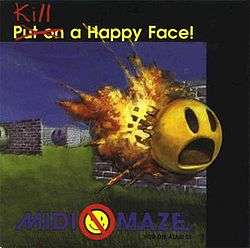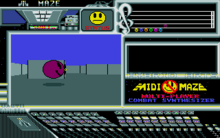MIDI Maze
| MIDI Maze | |
|---|---|
 Cover art | |
| Developer(s) | Xanth Software F/X |
| Publisher(s) |
Hybrid Arts Bulletproof Software |
| Platform(s) | Atari ST, Game Boy, Game Gear, SNES |
| Release |
Atari ST: July 10, 1987 June 23, 1991 July 31, 1992 June 15, 1993 |
| Genre(s) | First person shooter |
| Mode(s) | Multiplayer |

MIDI Maze is a networked first person shooter for the Atari ST developed by Xanth Software F/X and released in 1987 by Hybrid Arts. The game takes place in a maze of untextured walls. The world animates smoothly as the player turns, much like the earlier Wayout, instead of only permitting 90 degree changes of direction. It has been suggested that MIDI Maze introduced the concept of deathmatch combat.[1]
The original MIDI Maze team consisted of James Yee as the business manager, Michael Park as the graphic and networking programmer, and George Miller writing the AI/drone logic. The game uses the built-in MIDI ports on the Atari ST for networking.
Gameplay
Up to 16 computers can be networked in a "MIDI Ring" by connecting one computer's MIDI-OUT port to the next computer's MIDI-IN port. Unless the computers are looped correctly, more than 4 players slow down the game and make it unstable.
Graphically the game is very simple with a humorous twist. The game area itself occupies only roughly a quarter of the screen and consisted of a first-person view of a flat-shaded Pac-Man-like maze with a crosshair in the middle. All players are shown as Pac-Man-like smiley avatars in various colors.[2][3] Bullets are represented as small balls.
The game is started by one designated "master" machine, which sets rules, divides players into teams, and selects a maze. A number of mazes come with the game, and additional mazes can be constructed using a text-editor.
A prototype of MIDI Maze was found for the Atari 8-bit family. It is possible to connect ST and 8-bit to a network and play together.[4]
MIDI-Maze II and MIDImaze Plus
MIDI-Maze II was later developed by Markus Fritze for Sigma-Soft. This game was released as shareware and contained gameplay improvements over the original.
An improved variation, based more closely on the original MIDI Maze, was MIDImaze Plus from Robert and Werner Spahl, featuring a compass and more detailed info on players.
WinMaze, based on MIDI-Maze II, supports up to 32 Windows-based players networked via LAN, includes a number of enhancements from the original and claims to be "The best MIDI-Maze II clone ever!". WinMaze is authored by Nils Schneider (with thanks to Jens "Yoki" Unger, who provided socket classes and created the first server version), while Heiko "phoenix" Achilles provided the game's graphics.
Faceball 2000
A Game Boy version was developed by the original developers, Xanth Software F/X, and published in 1991 by Bulletproof Software (now Blue Planet Software), under the title Faceball 2000.[5] James Yee, owner of Xanth, had a vision to port the 520ST application to the Game Boy. George Miller was hired to re-write the AI-based drone logic, giving each drone a unique personality trait. It is notable for being the only Game Boy game to support 16 simultaneous players. It did so by connecting multiple copies of the Four Player Adapter to one another so that each additional adapter added another two players up to the maximum - seven such adapters were needed for a full 16 player experience.
A SNES version, programmed by Robert Champagne, was released the following year, supporting two players in split-screen mode. The SNES version features completely different graphics and levels from the earlier Game Boy version. A variety of in-game music for this version was composed by George "The Fat Man" Sanger.
A Game Gear version, programmed by Darren Stone, was released to the Japanese market.[6] It is a colorized version of the monochrome Game Boy edition, supporting two players via two handhelds connected by a cable.
A version for the PC-Engine CD-ROM, simply titled Faceball, was also available in Japan. A multiplayer networked version for the IBM PC was prototyped, but never released. Faceball was nearly completed and built for Nintendo's Virtual Boy console, but it was canceled.
Reception
Entertainment Weekly picked Faceball 2000 as the #5 greatest game available in 1991, saying: "The Game Boy meets virtual reality (i.e., artificial, computer-enhanced, first-person perspective). In Faceball 2000, you assume the identity of a Holographically Assisted Physical Pattern Yielded for Active Computerized Embarkation — or HAPPYFACE — and hunt down your opponents. You can play alone or link up with as many as three additional players. More fun than real-life tag, and much more stimulating."[7] Faceball: 2000 was reviewed in 1994 in Dragon #201 by Sandy Petersen in the "Eye of the Monitor" column. Petersen gave the game 2 out of 5 stars.[8]
CNET Gamecenter named MIDI Maze one of the 10 most innovative computer games of all time.[9]
See also
References
- ↑ Thomson, Iain. "Gaming timeline." Personal Computer World. 2008-02-21. Retrieved 2012-10-21 via HighBeam Research. URL.
- ↑ "25 years of Pac-Man". MeriStation. July 4, 2005. Retrieved 2011-05-06. (Translation)
- ↑ "Gaming's Most Important Evolutions". GamesRadar. October 8, 2010. p. 5. Retrieved 2011-04-27.
- ↑ Reichert, Matt. "MIDI Maze". AtariProtos.com. Retrieved 2007-11-27.
- ↑ Schiffmann, William. "In your Face! New toy will wow Game Boy owners." Chicago Sun-Times. 1992-05-22. Retrieved 2012-10-21 via HighBeam Research URL.
- ↑ Komarechka, Don. "Interview: EPO talks to Darren Stone about Faceball 2000." Electric Pickle Online. 2006-03-19. Retrieved 2012-10-21.
- ↑ https://ew.com/article/1991/11/22/video-games-guide/
- ↑ Petersen, Sandy (January 1994). "Eye of the Monitor". Dragon (201): 57–62.
- ↑ https://web.archive.org/web/20000615070900/http://www.gamecenter.com:80/Features/Exclusives/Hallofgame/ss04.html
External links
- MIDI Maze at Atari Mania
- MIDI Maze fan site (German)
- MIDI Maze Utilities
- Faceball 2000, #25 of 1up.com's Essential 50
- Faceball 2000 fan site
- Faceball 3000